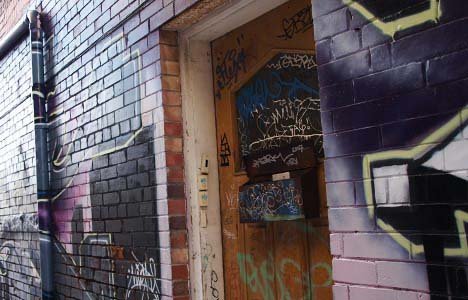
Kensington Market is headed for an artistic revitalization courtesy of an unlikely source – Rob Ford’s anti-graffiti program.
The mayor’s crackdown on street art has been ridiculed for its reliance on smartphone apps, and his war on tagging has provoked an outraged, if often creative, response from artists themselves.
But on Thursday at City Hall the licensing and standards committee had some good news for local artists. The committee approved a list of groups that staff is recommending receive more than $200,000 under the new StreetARToronto (StART) initiative, which was created last year as part of the mayor’s anti-graffiti offensive.
Toronto’s vibrant tag-ridden enclave is to be the primary beneficiary of the grants – one-third of the 15 projects approved by staff would adorn public space in or near the Kensington Market district at Dundas and Spadina. Total investment in the area would be over $60,000.
Among the groups approved for funding by the committee Thursday are the Whippersnapper Gallery, the Kensington Market BIA, St. Stephen’s House, and the Scadding Court Community Centre. The grants, which vary in size from $4,200 to $20,000 still have to be approved by council.
“I think it’s wonderful the city’s investing,” says Yvonne Bambrick, head of the Kensington Market BIA, which hopes to use the money for murals at four different sites in the quarter. “It will certainly add some high quality art work to Kensington Market and the surrounding neighbourhood. It sounds like really dedicated organizations with track records in this type of work have been selected.”
Elyse Parker, the city director in charge of StART, says it wasn’t intentional that projects near Kensington receive the bulk of the funding, but it’s only logical.
“There was a concentration in the downtown for sure, but at the same time that’s where we get a lot of graffiti vandalism and a lot of these [projects] are intended to counter graffiti vandalism,” she says.
For years, the city has given grants for public art designed to deter illegal tagging by taking up wall space that would otherwise be prime targets for illicit spay painters. But last year the Ford administration canceled the Graffiti Transformation Program, which paid community groups to hire youth to paint murals, and replaced it with StART, which focuses on professional non-profit arts groups instead.
The new program sets a higher bar for applicants grant recipients must be able supply a minimum of 50 per cent of the project’s budget either in cash or in kind donations. Parker says the new model allows the city to engage a “higher caliber” of artist, and approach public art projects in a less ad hoc manner than under Graffiti Transformation Program.
She adds that only “one or two” applicants were turned down because they couldn’t put up their half of the budget.
StART is having trouble attracting appropriate projects in its inaugural year however. While $353,940.00 has been allocated to the program, staff rejected 11 of 26 applications they received by the April 30 deadline, and are only recommending $225,357 worth of grants at this time.
Parker blames the dearth of qualified groups on the original application timeline, which she says was too short (a request for proposals wasn’t made until March).
Staff created a second application cycle that ended on May 23, and advised those rejected on how they could improve their proposals to be accepted the second time around. Parker hopes to use up the remainder the program’s budget on new approvals.
“We’ve really been sensitive of this transitional year and tried to be as inclusive as possible,” she explains.
One artist who won’t need to take a second crack at his application is Dan Bergeron, whose plans to install life-sized tile portraits of tai chi practioners throughout the neighbourhood has already been given the green light.
Bergeron, who is known for his outsized portraits of Regent Park residents, is working with the Whippersnapper Gallery on the project. He says the Chinatown/Kensington area was perfect place to erect figures in calming postures.
“It just seemed like a good neighbourhood to work in because there is a lot of tagging, graffiti, advertising. So there’s a lot of visuals, but those are very aggressive,” he said. “These people doing poses is a good juxtaposition against all the other visuals that are surrounding it.”
bens@nowtoronto.com | @BenSpurr












